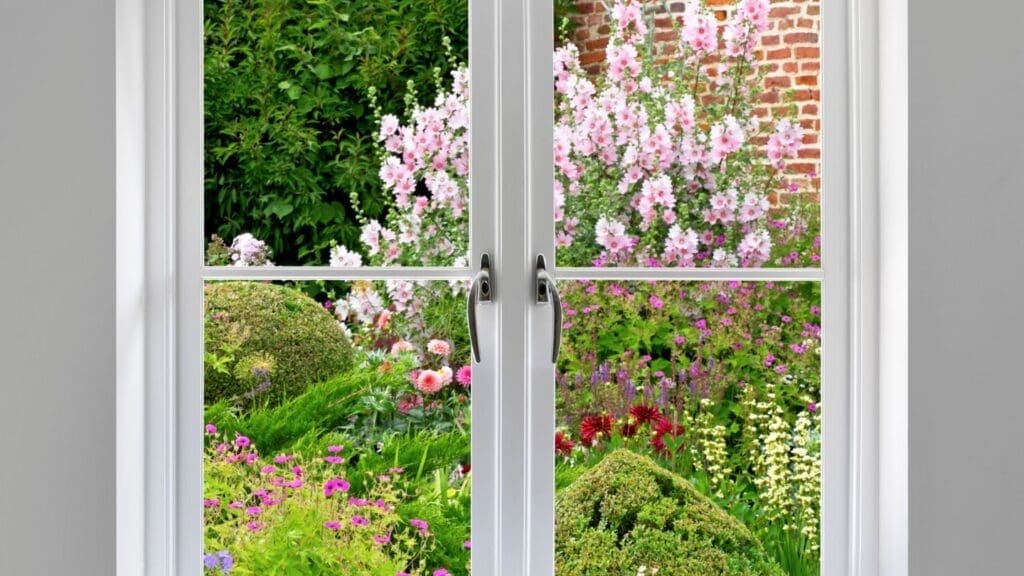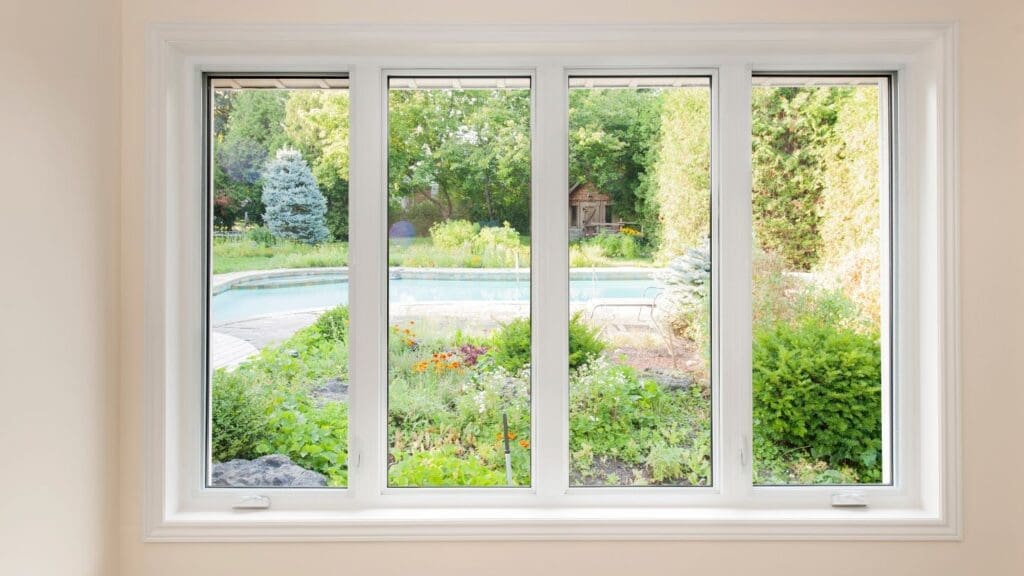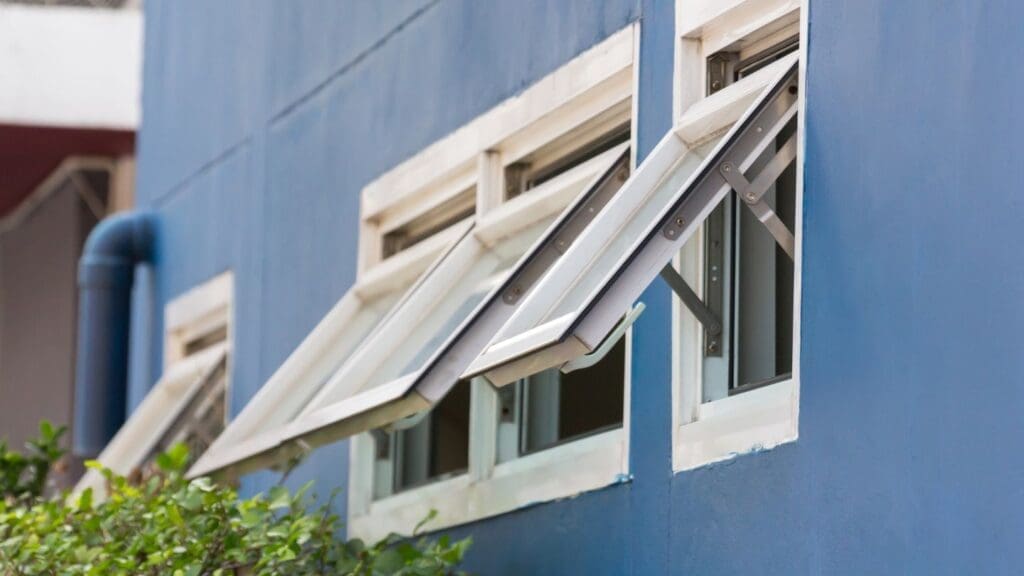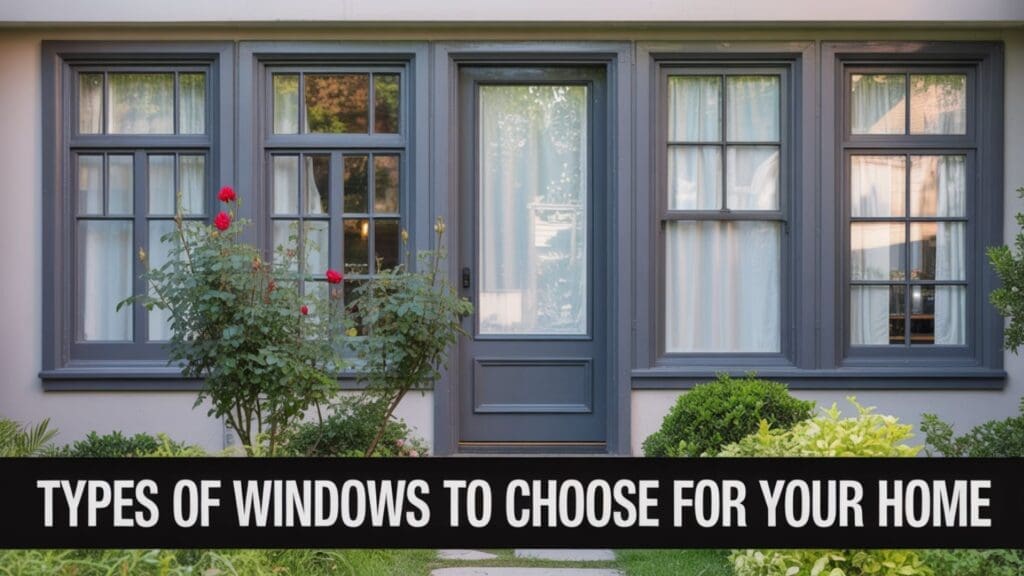Selecting the right windows plays a critical role in enhancing your home’s visual appeal, energy efficiency, and overall comfort. From maximizing natural light to improving ventilation, different window styles serve distinct functional and aesthetic purposes. Whether you’re upgrading for curb appeal or functionality, understanding the available options is essential. Each window type offers unique features, benefits, and design considerations that impact long-term performance and value.
In this blog, we break down the types of windows to choose for your home, highlighting their advantages, ideal placements, and key decision factors.
Key Takeaways
- Single-hung and double-hung windows are popular choices due to their affordability and versatility, with single-hung windows being more cost-effective and easier to maintain.
- Casement and awning windows provide excellent ventilation and energy efficiency, making them suitable for areas that require maximum airflow, despite some operational space limitations.
- Specialty and picture windows enhance aesthetics and natural light but come with limited ventilation options, making them ideal for unique design solutions.
Single-Hung Windows
Single-hung windows are a timeless choice, praised for their simplicity and affordability. Key features include:
- A fixed upper sash and a movable lower sash
- Ventilation through the bottom pane
- A classic appeal that suits many home styles
- Straightforward design that makes them easy to install
These qualities make single-hung windows a favorite among budget-conscious homeowners, highlighting the single-hung windows’ pros.
While single-hung windows are known for their cost-effectiveness, they also come with certain limitations. The fixed upper sash restricts ventilation to only the bottom sash, which might not be sufficient in some scenarios. Despite this, single-hung windows are easy to maintain with only one sash to close and lock, making them a practical option for many homes.
Best Places for Single-Hung Windows
Single-hung windows are particularly well-suited for bedrooms and living areas where space constraints exist. They are also ideal for spaces requiring frequent ventilation, such as kitchens and bathrooms.
The design of single-hung windows makes them a practical choice for areas where maximizing ventilation and space efficiency is important. Their classic design is versatile, fitting seamlessly into various home styles.
Pros & Cons of Single-Hung Windows
Single-hung windows are generally more affordable than double-hung or other types, making them a popular choice for budget-conscious homeowners. Their cost-effectiveness is a significant advantage, but they do have some limitations. A single hung window can be an excellent option for those looking to save on costs.
Double-Hung Windows

Double-hung windows, one of the most common types of windows found in homes, are celebrated for their versatility and classic appeal. Approximately 26.4% of homeowners have chosen many double hung windows, making them a popular choice for both new constructions and renovations. These windows feature two independently operable sashes, allowing for ventilation from both the top and bottom, which enhances airflow and comfort within the home. The double hung window style is particularly favored for its functionality and aesthetic, making the double hung window a preferred option.
The design of double-hung windows facilitates effective airflow, with the top sash releasing hot air and the bottom sash letting in cooler air. They are widely manufactured and affordable.
Best Places for Double-Hung Windows
Double-hung windows are ideal for traditional homes due to their classic aesthetic and versatility. They fit well in locations where space is limited, such as next to pathways or outdoor decks.
These windows are particularly useful in upper levels of homes, allowing for easier cleaning and maintenance. Their ability to provide effective ventilation by allowing both fixed top sash and bottom window sash to open, with windows open, makes them a practical choice for many settings.
Pros & Cons of Double-Hung Windows
Double-hung windows provide improved airflow by allowing warm air to escape from the top while cooler air enters from the bottom. They are easy to clean due to the tilt-in sash feature, which allows homeowners to clean both sides of the windows from indoors.
However, double-hung windows can experience energy loss due to potential air leaks, making them less energy-efficient compared to some other window types. Despite this, their ease of cleaning and ventilation benefits make them a popular choice for many homeowners.
Casement Windows

Casement windows are known for their excellent ventilation and clear, unobstructed views. Key features include:
- Hinged on the side and casement windows open outward, providing maximum airflow
- Provide a weathertight seal when closed, making them highly energy-efficient
- Operated using a hand crank, lever, or cam handle
- Available in various materials including wood, vinyl, aluminum, fiberglass, and casement window options
Despite their advantages, casement windows do require more clearance for opening, which can be a consideration in some installations. In windy conditions, they can be at risk of being damaged if fully extended. However, their ability to open fully to catch breezes and their elegant style make them a desirable choice for many homeowners.
Best Places for Casement Windows
Casement windows operate with a crank handle, allowing easy opening and closing. Their design makes them ideal for installation above kitchen sinks or in bathrooms, where maximum ventilation is desired.
These locations benefit from the full opening capability of casement windows, making them practical and efficient choices for enhancing airflow.
Pros & Cons of Casement Windows
Casement windows provide excellent ventilation by allowing them to open fully to catch breezes, offering great airflow and an elegant style that enhances the appearance of a home. They contribute to energy efficiency by helping to maintain the interior temperature effectively.
However, they require exterior space to operate properly, and the crank mechanisms can wear out over time, leading to potential maintenance issues.
Awning Windows

Awning windows, hinged at the top and opening outward, are designed to offer excellent ventilation and insulation. They are particularly effective in areas that require frequent ventilation, such as kitchens and bathrooms. These awning windows open outward and are known for their ability to provide ventilation even during light rain, thanks to their unique design.
One of the key advantages of awning windows is their ability to allow airflow without letting rain in. However, cleaning the exterior of awning windows can be challenging and may require a ladder for higher placements. Despite this, their functionality and ability to maximize natural light make them a practical choice for many homes.
Best Places for Awning Windows
Awning windows are particularly effective in areas that require frequent ventilation, such as kitchens and bathrooms. Their design allows for ventilation without letting rain in, making them suitable for spaces that need to maintain airflow in various weather conditions.
These windows maximize natural light and unobstructed views due to their placement on a high exterior wall, allowing natural light to flood the space.
Pros & Cons of Awning Windows
Awning windows offer excellent rain protection while allowing ventilation, making them ideal for areas like kitchens and bathrooms. They allow better airflow even during rain due to their outward-opening design, which is a feature of an awning window.
However, cleaning the exterior of awning windows can be challenging, and they may obstruct views when opened, especially if situated at eye level. Additionally, opening awning windows can obstruct walkways, posing a potential inconvenience.
Sliding Windows
Sliding windows have several key features and advantages:
- They open horizontally by moving along a track, making them easy to operate.
- Their design maximizes the glass area, providing unobstructed views and ample natural light.
- They are ideal for spaces with limited vertical clearance.
- Sliding windows are commonly used in contemporary homes.
One of the key features of sliding windows is their low maintenance requirement, as they have fewer moving parts compared to other window types. However, they have some drawbacks, including limited ventilation since only one side can be opened at a time.
Despite this, their space-saving design and ease of operation make them a popular choice for many homeowners.
Best Places for Sliding Windows
Sliding windows are often installed in interior living spaces where space is limited, such as hallways. They are particularly useful in contemporary homes and spaces with limited vertical clearance, allowing for ease of operation and effective utilization of limited spaces, including a slider window.
Their space-saving design makes them ideal for hard-to-reach areas with limited wall space, where traditional windows might not be practical, such as a window unit.
Pros & Cons of Sliding Windows
Sliding windows offer:
- A space-saving design that is ideal for homes with limited vertical clearance
- Clear views without any obstructions
- Plenty of natural light in the home
However, they have some drawbacks, including limited ventilation since only one side can be opened at a time. Additionally, they may face sealing issues, making them less effective in insulation compared to casement windows.
Bay and Bow Windows
Bay windows and bow windows are designed to extend outward from the wall, providing panoramic views and enhancing natural light. A bay window typically features a central large window flanked by smaller windows, creating a distinct look with sharp angles. Bow windows, on the other hand, present a gentle curve with multiple smaller windows, offering a softer aesthetic.
These windows are suitable for dining rooms and living areas, adding space and natural light while enhancing the home’s exterior with distinctive architectural features.
Decorating Around Bay and Bow Windows
Utilizing the space around bay or bow windows allows for creative decorating opportunities. Creating a seating area within bay or bow windows can enhance the room’s comfort and usability. Homeowners should harmonize their bay and bow window choices with their home’s style, ensuring they provide light and ventilation while maintaining privacy.
A popular placement for bay and bow windows is in living rooms, where they can maximize both views and light.
Pros & Cons of Bay and Bow Windows
Bay and bow windows enhance a home’s exterior by adding distinctive architectural features, thereby increasing curb appeal and property value. They increase natural light, visually expand rooms, and bay windows offer enhanced aesthetics.
However, bow windows generally involve higher costs and more complex installation processes than bay windows. Despite the higher costs, their ability to enhance both interior and exterior spaces makes them a valuable addition to many homes.
Picture Windows
Picture windows are designed to frame outdoor views, providing expansive, unobstructed vistas and maximizing natural light within the home. Unlike operable windows, picture windows are fixed, meaning they do not open and therefore offer excellent weather resistance and energy efficiency. They are often larger and have slimmer frames, creating a clearer view and a bright, airy atmosphere.
The primary purpose of picture windows is to capture beautiful views and enhance the aesthetic appeal of living spaces. They are often used in living rooms, dining areas, and hallways to bring in more natural light and create a focal point.
While they do not provide ventilation, their ability to prevent air leakage and require low maintenance makes them a popular choice for homeowners looking to enhance their home’s interior and exterior appeal, especially when minimizing air leakage compared to other options is considered, particularly in terms of indoor air quality.
Best Places for Picture Windows
Ideal locations for picture windows include living rooms, dining areas, and hallways, where they can enhance natural light and provide expansive views. These spaces benefit from the large, fixed panes of glass that offer unobstructed vistas and contribute to a bright, open atmosphere.
Picture windows can serve as a stunning architectural feature, making them the best windows for areas where views and light are prioritized. A picture window can enhance the overall aesthetic of a space.
Pros & Cons of Picture Windows
Picture windows provide significant energy efficiency by preventing air leaks, thanks to their fixed design. They require low maintenance and maximize sunlight entry, creating a bright and inviting atmosphere. However, one significant disadvantage is that they do not provide ventilation, which might be a limitation for some homeowners. Additionally, their large, fixed panes can be challenging to clean. If you’re considering a window replacement, it’s essential to weigh these factors carefully.
Despite these drawbacks, their ability to enhance both interior and exterior appeal makes them a valuable addition to many homes.
Specialty Windows (Custom Shapes)
Specialty windows, often custom-shaped, include an array of designs such as circles, ovals, and triangles. These windows serve as architectural accents, enhancing the design and character of a home. Specialty windows can be used to fit specific spaces or create focal points, adding unique and distinctive elements to any home. They are particularly suitable for oddly shaped wall areas, allowing for creative design solutions.
While specialty windows offer unique aesthetics and customization, they come with certain challenges. Higher costs and potential installation complexities are common drawbacks associated with custom-shaped windows. Despite these challenges, the ability to enhance a home’s beauty and character makes specialty windows a compelling choice for homeowners looking to add a touch of elegance and uniqueness to their living spaces.
Enhancing Home Design with Custom Windows
Specialty windows come in custom shapes like circles and arched windows, adding unique architectural elements to your home. The unique aesthetics offered by custom-shaped windows contribute to the overall character and beauty of a home.
While they can be more expensive and complex to install, their ability to enrich home design and provide increased natural light makes them a valuable investment for many homeowners.
Pros & Cons of Specialty Windows
Specialty windows provide unique aesthetics that enhance the architectural beauty of a home, offering design versatility and allowing for increased natural light within the home. However, they may come with higher costs and involve limited ventilation compared to standard windows. Installation can also be more challenging due to their custom shapes and requirements.
Considering both the pros and cons, specialty windows can be a valuable investment for enhancing home design, given careful evaluation of costs and installation.
Transom Windows
Transom windows are generally fixed windows designed to enhance natural lighting in various parts of a home. They are often placed above doors or larger windows, providing additional light and ventilation.
These jalousie windows add decorative appeal and can be a beautiful addition to entryways and bathrooms, enhancing both aesthetics and functionality.
Best Places for Transom Windows
Transom windows are placed above doors or larger windows, providing additional light and ventilation. They are particularly suitable for entryways and bathrooms, where they can enhance natural lighting and airflow without compromising privacy.
The decorative appeal of transom windows also adds to the charm and elegance of these spaces, making them a popular choice for enhancing home interiors.
Pros & Cons of Transom Windows
Transom windows provide added light and have decorative appeal, enhancing the aesthetic of a home. However, one of the main drawbacks is the difficulty in cleaning them due to their elevated position. Additionally, they may lead to energy loss and increased solar heat gain if they are not well-insulated.
Despite these challenges, modern transom windows serve primarily for natural lighting, making them a valuable addition to many homes.
Glass Block Windows
Glass block windows consist of thick glass units that are arranged like a brick wall, providing a unique aesthetic and privacy while allowing light to filter through. These windows are often used in bathrooms and basements, where privacy and natural light are desired.
Glass block windows are made of individual glass blocks sealed together, making them secure and difficult to break, providing a tight seal.
Best Places for Glass Block Windows
Glass block windows are commonly used in bathrooms and basements for privacy and natural light. They are particularly effective in shower areas, where they provide privacy without obstructing light.
Additionally, glass block windows can enhance the brightness of basements by letting in natural light while maintaining security due to their solid construction.
Pros & Cons of Glass Block Windows
Glass block windows provide privacy while allowing light to filter through, making them ideal for bathrooms and basements. They offer excellent insulation, helping to maintain indoor temperature. However, one notable disadvantage is their inability to offer effective ventilation, as they cannot be opened.
Additionally, they can be heavy and may require a solid foundation for installation. Despite these drawbacks, their unique aesthetic and functionality make them a valuable addition to many homes.
When planning a window upgrade, understanding what to look for in a window installation service is just as critical as choosing the window style itself. Factors like licensing, installation expertise, warranty coverage, and post-installation support can directly impact long-term performance and satisfaction. An experienced provider ensures not only proper fit and finish but also compliance with local codes and energy standards.
Final Thoughts
Selecting the best window style for your home involves balancing form, function, and performance. From traditional single-hung and double-hung models to energy-efficient casement and awning windows, each option offers distinct advantages. Sliding windows maximize space in compact areas, while bay, bow, picture, and specialty windows elevate aesthetics and natural light. Transom and glass block windows add unique visual and functional benefits, helping you tailor every room to your design and lifestyle needs.
For homeowners exploring options for windows in Houston, Advanced Window Products provides a wide range of solutions backed by expert guidance and quality craftsmanship. Whether you’re renovating or building new, their team can help identify the best window styles to match your goals and architectural preferences.
Frequently Asked Questions
What are the main benefits of single-hung windows?
Single-hung windows are a cost-effective option that requires minimal maintenance while providing a timeless aesthetic that complements different home styles.
Why are double-hung windows popular among homeowners?
Double-hung windows are popular among homeowners due to their ability to facilitate airflow, ease of cleaning, and classic aesthetic that complements various architectural styles. Their functional and visual appeal make them a favored choice for many.
What makes casement windows energy-efficient?
Casement windows are energy-efficient due to their ability to create a weathertight seal when closed, effectively maintaining interior temperature and minimizing energy loss. This feature contributes significantly to overall energy efficiency.
Where are awning windows most effectively used?
Awning windows are most effectively used in kitchens and bathrooms, as they provide excellent ventilation while protecting against rain.
How do glass block windows provide privacy and security?
Glass block windows ensure privacy and security by using thick glass units that permit light to enter while obscuring visibility from the outside. Their solid construction enhances durability, making them a reliable choice for both protection and aesthetic appeal.
